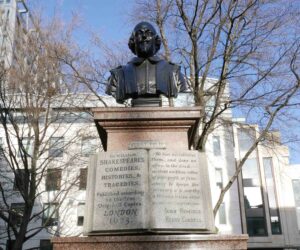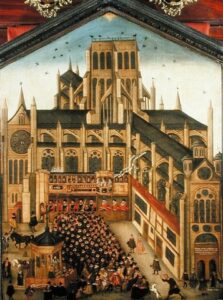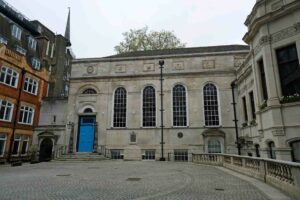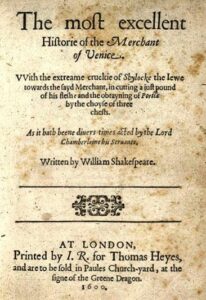St Paul’s Churchyard, the area surrounding St Paul’s Cathedral, has been the epicentre of life in the City of London for centuries and in William Shakespeare’s time was also the centre of the book trade. Shakespeare lived a stone’s throw away, in the area known as Blackfriars, and the First Folio – the first collected edition of Shakespeare’s plays – was first sold in St Paul’s Churchyard and celebrates its 400th anniversary on 8th November 2023. So, let’s take a walk in Shakespeare’s footsteps and explore St Paul’s Churchyard in the Elizabethan period along with its connections to the book trade and Britain’s greatest playwright.
Shakespeare’s First Folio
Many claim that the First Folio is the most important collection of plays ever published, and as it contains 36 of the 37 plays written by Shakespeare, this claim is not an exaggeration. Without it we would only have printed versions of 17 of Shakespeare’s plays and we would not have copies of Twelfth Night, Macbeth and The Tempest. In addition to giving us 18 previously unpublished plays, the First Folio also gave us one of the two definitive portraits of William Shakespeare in the form of a frontispiece by Martin Droeshout, a Flemish engraver.

The First Folio was published in 1623, seven years after the death of Shakespeare, and is closely connected to the City of London. The plays were collated by his friends John Heminge and Henry Condell, who are buried and memorialised in the garden of St Mary Aldermanbury near Guildhall. The First Folio was published by William Jaggard at his shop in the Barbican and sold in St Paul’s Churchyard in the bookshop of Edward Blount, at the sign of the Black Bear.

Stationers Company
It is not surprising the First Folio was sold in St Paul’s Churchyard as it was the place to buy books in London in Shakespeare’s time, and the area’s association with the book publishing business stretches back even further.
Before the arrival of the printing press, scriveners who wrote medieval texts with quills, and limners who provided the illustrations, were located on Paternoster Row, to the north of the Cathedral, naturally gravitating towards St Paul’s and the many monastic foundations in the City of London who were their main clients. These traders would sell their services from “stations” or barrows in the area of the Churchyard near St Paul’s Cross, located northeast of the Cathedral, with the practice continuing after the arrival of the printing press.

These stations also gave us the word “stationer” and the medieval scribes formed a guild in 1403. They embraced the new technology of the printing press and in 1557 they received a Royal Charter and became the Stationers Company. They are still close to St Paul’s Churchyard with their livery hall located on nearby Ave Maria Lane.

Originally, books could be published by anyone, but from the mid-sixteenth century the Stationers Company regulated the book trade, keeping a register of books and recording who had the right to publish each book. Once the right to publish a book was given to a person and registered, no other member of the Stationers Company could publish the book without the licence from the owner – a right which later became the law of copyright.
The Book Trade in St Paul’s Churchyard
As well as the book trade, the Churchyard was a bustling centre of commerce in Shakespeare’s time and a place to be seen by the wealthy merchants who lived nearby. Many trades were conducted here either in the Churchyard or even in the nave of old St Paul’s Cathedral, and Shakespeare mentions this in Henry VI, Part II, when Falstaff recalls that he purchased his servant Bardolph at St Paul’s.
As not everyone could read, shops and traders identified themselves via their signs, and ironically the booksellers in St Paul’s Churchyard did the same. So, Shakespeare’s ‘Venus and Adonis’ and ‘Rape of Lucrece’ were published by John Harrison at the sign of the White Greyhound, while the ‘Merry Wives of Windsor’ was published at the sign of the Fleur de Luce and the ‘Merchant of Venice’ was published at the sign of the Green Dragon.

Shakespeare himself would have visited the book sellers in St Paul’s Churchyard, browsing the newest books, and would have found on sale in the Churchyard, Holinshed’s ‘Chronicles of England, Scotland and Wales’, a primary source for his history plays, as well as Sir Thomas North’s ‘Plutarch’s Lives of the Greeks and Romans’ and a translation of Ovid’s Metamorphoses, sources for the classical legends and allusions which pepper his plays.
John Gerard published ‘The Herball or Generall Historie of Plantes’ in 1597 in the Churchyard, and a few years later Shakespeare wrote his famous speech for Ophelia in Hamlet, where, in her madness and grief she hands out flowers, giving rosemary to her brother Laertes for remembrance, fennel and columbines to the Queen, symbolising adultery, and rue to the King and herself, signifying repentance and sorrow.
Scholars think about 750 copies of the First Folio were printed, with some 233 copies of the First Folio still in existence, and copies can be seen at the British Museum and the Globe, which has designed an entire alphabet based on the First Folio for its Summer 2023 season. In 1623, the First Folio would have cost 15 shillings for an unbound copy and 20 shillings for a bound copy. This would have been a considerable amount of money then and equivalent to 2 months’ wages of a skilled worker, making it a prestige item for the elite. That is still true today, as in 2022 a copy of the First Folio was sold in New York for £2.4 million. Luckily, his plays can be enjoyed by us all for much less.
If you want to discover more secrets about St Paul’s Churchyard, come on the Murder, Mayhem and Memorials tour around St Paul’s Churchyard.
